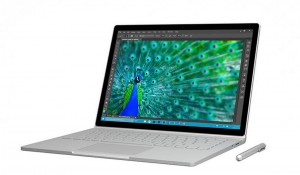Share This
Related Posts
Tags
Microsoft Surface Book
By Anca Gagiuc on Oct 22, 2015 in Technology
On October 6 Microsoft took its fall hardware collection to New York, raisin g many eyebrows with its first laptop ever—the Surface Book.
g many eyebrows with its first laptop ever—the Surface Book.
The long-awaited device (so long, that many believed it would never happen) bears the genes of the Surface family with its 2-in-1 mobile experience. Yet, it adds something the previous models lack: a stiff hinge. The Surface Book is still a tablet with a separate keyboard, but there’s no kickstand. The Dynamic Fulcrum hinge (which resembles a tiny metal gauntlet) holds the screen up and allows positioning it at any angle.
The screen is firmly anchored into the keyboard/battery base; it can be ejected either through the physical eject button or through the one included in the software. The result is an incredibly thin but generous 13.5-inch, 3000×2000 screen, a standalone tablet.
And this is not all—the screen can be reattached backwards to the laptop base, allowing to fold the tablet over the keyboard. It is what Microsoft calls the “drawing mode”.
The look of the Surface Book will be divisive: the dynamic fulcrum hinge doesn’t completely close, the screen isn’t flush against the keyboard—look from the side and there is a gap. This might be unpleasant for some, despite the rest of the polished features.
By far, this is the most beautiful Windows laptop ever made; it feels solid, well-engineered and designed, even though some might make a wry face when seeing its unadorned, almost industrial look. Microsoft’s newest star has an angular silver magnesium casing adorned with just two physical buttons—for volume and power. It measures 12.30” x 9.14” x 0.51 – 0.90” and weighs 3.34 pounds, including the keyboard.
The screen sports 6 million pixels, 267 per inch, surpassing MacBook Pro’s 227ppi and making colors pop. The Surface Book has good viewing angles and Microsoft’s new, trademark PixelSense technology provides solid touch and pen responsiveness.
The keyboard unit and the glass touchpad eclipse anything previously branded Surface. The keys feel crisp, with good travel, and a great amount of punch. The touchpad on the other hand, will need a whole lot more testing to get the real sense of how it compares to Apple’s touchpads, but at least this one should be usable without making users aching for a mouse.
Microsoft claims the Surface Book’s battery should go on for about 12 hours on a single charge while both parts are connected. There is also a smaller battery in the screen that powers the tablet for three hours when disconnected from the laptop base. Connectivity-wise, it offers 802.11ac Wi-Fi and Bluetooth 4.0 LE. Two USB 3.0 ports are crammed onto the side of the Book, as well as a full-size SD card reader, mini DisplayPort, a headphone/microphone jack and Microsoft’s own Surface Connect port for power and docking. The device has two cameras: a 5MP front-facing one with Windows Hello face authentication and an 8MP in the back—both can record 1080p video.
The 6th generation Intel Core i5 (or i7) processor is located in the tablet portion, enabling it to function as a computer when detached. However, the graphics processing unit (i5: Intel HD graphics 520 or i5/i7: NVIDIA GeForce GPU with 1GB GDDR5 memory) sits in the base, meaning that whenever the device is used for something graphics intensive, the two will need to be connected.
A less attractive feature is the price. The Surface Book starts at $1,499 for a Core i5, 8GB RAM with a 128GB SSD. And wait for it, this system doesn’t include a discrete GPU—the cheapest Surface Book with the discrete GPU is $1,899, which is still a Core i5 with 8GB, but boosts the storage to 256GB. The top spec is a Core i7 with 16GB RAM and a 512GB SSD and it ships for $2,699.
